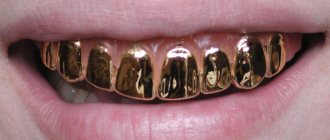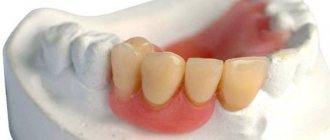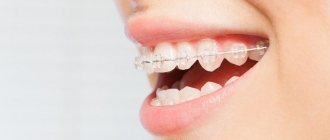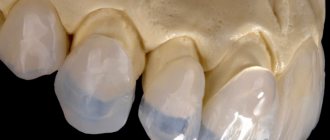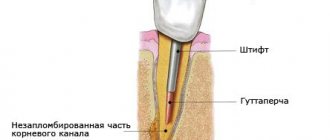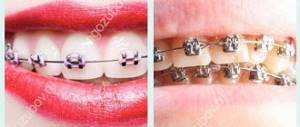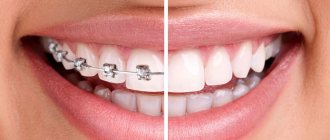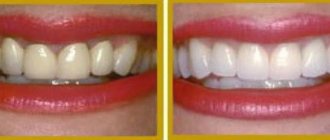8215
© Berchtesgaden / Fotolia
Methods of dental prosthetics that require grinding are already becoming a thing of the past. Adhesive bridges, the CBW system, flexible removable structures, as well as implantation and microprosthetics are modern solutions that allow you to install a crown autonomously. Let's consider each of them in detail and analyze the advantages and disadvantages.
Advantages and disadvantages
The popularity of alternative methods of restoring teeth without grinding is growing every day, thanks to one but big advantage: maintaining the integrity of the upper part and the neurovascular bundle of healthy, adjacent teeth, which is impossible with traditional technology .
Teeth are not deprived of their nutrition and can continue to function throughout a person’s life. In addition, all methods of prosthetics without turning, not counting implantation, take a short period of time.
© elivagar / Fotolia
Some methods allow you to restore the aesthetics of your teeth in one visit to the dentist . In this case, the new crowns will be immediately ready for functional loading.
These advantages are fundamental when choosing between alternative and traditional prosthetic methods. But in addition to the positive aspects, restoring teeth without preparation also has a number of significant disadvantages:
- low strength of some types of structures. Due to the lack of a wide supporting area, certain types of prostheses are not able to withstand large constant loads;
- narrow range of indications . Each type of correction of a number of teeth is intended for use only in certain cases. For example, only for placing on the chewing group or incisors;
- limited material capabilities . With certain methods, only a composite can be used, which quickly loses its presentation during use and is a common cause of the development of caries on healthy teeth.
When choosing a recovery method, you should focus on the pros and cons of each specific method.
The varieties of this technology will be discussed in the following video:
How to restore teeth without grinding
If restoring a lost tooth with a bridge is not an option, you can consider other options. The main ones:
- Installation of a crown on an implant.
- Wearing a butterfly prosthesis.
- Adhesive prostheses.
- Bridges without turning.
These options allow you to leave healthy adjacent teeth undamaged while filling the empty space.
PROMOTION
Place a Quadrotti denture
30,000 rub.
Methods used
Today, orthodontics offers several options for prosthetics without preparation of adjacent units. All methods differ in indications, service period and methodology.
Of the methods listed below, only implantation refers to permanent prosthetics . The remaining methods, most often used as temporary options, and only if there are contraindications for implantation of a metal root, can be installed permanently.
Microprosthetics
Microprosthetics is a young method that has quickly become popular among dental patients. It is used to restore partially destroyed units or those with low aesthetic appearance (darkening of the enamel, multiple cracks).
There are two types of this technique:
Veneers
© Kurhan/Fotolia
They are thin overlays designed to be applied to the surface of the front teeth in case of chipping, deformation, cracking, or change in shade. A selection of photos before and after installation is posted here.
Tabs
They are used when the crown part of the lateral teeth is destroyed by more than half. Composite and ceramic tooth inlays are used. They imitate the missing part and are fixed in the formed cavity.
The main advantage of both methods is that the preparation is carried out only on damaged units, and adjacent ones are not affected.
We'll tell you what an orthopedic dentist does and what problems he solves.
Read reviews about President denture fixation cream here.
Which is better, a crown or an implant?
If the root remains
It is not for nothing that dentists advise saving a tooth, even if its upper part is completely destroyed. The pulpless and healed root is used as a support for the crown.
An inlay is formed from the remaining dental tissue, a crown is made for it and fixed. Neighboring teeth are not affected.
Dante's method
Restoring worn teeth using carbon fiber. The method was invented by specialist Alexander Dante. The supporting teeth are not depulped or ground down; the doctor processes them with a laser, makes small holes for attaching an artificial crown and installs a carbon fiber prosthesis. Then it is treated with heliopolymers to give it a natural look.
The load is distributed evenly between the supporting teeth and the prosthesis.
Cable prosthetics
Fastening the denture with a thread that is pulled between the supporting teeth. For this purpose, holes are made in them, which are sealed after laying and tensioning the thread.
The main advantage of the method is the preservation of tooth mobility. Suitable for patients suffering from gum disease. The disadvantage is that the thread is visible through the filling material.
Flexible removable designs
© Ocskay Bence / Fotolia
One of the cheapest options for restoring the integrity of teeth is prosthetics with flexible removable structures. nylon dentures are used for this , which are suitable for replacing missing premolars and molars.
Such designs are a single nylon base that follows the relief of the sky and imitates the surface of the gums, on which artificial crowns are located.
They are used to close defects that include several consecutive crowns or the entire missing row of both the upper and lower jaws. The structure is held in place by the elasticity of nylon, which tightly grips the gums.
For additional fixation, the product is equipped with clasps, which are placed on several supporting teeth. At the same time, they do not require preliminary grinding, since the fixation system is held in place by the natural relief of the teeth.
The advantages of this method include the absence of preparation, the safety of the materials used and the long service life of the structure.
But such prostheses also have a certain disadvantage associated with their increased flexibility. Because of this, it does not have sufficient stability, as a result of which it can rub the mucous membrane and simply make the process of use uncomfortable.
This article contains a detailed review of nylon dentures: description, indications, care, prices, reviews and much more.
What the doctor says about nylon removable bridges:
CBW system
This system is used to restore one lost tooth if there are healthy ones nearby. In dental clinics, CBW is positioned as a prosthetic option that does not require preparation of adjacent teeth.
But this is not entirely true. The procedure does not require grinding the entire coronal part, but involves using a drill to form microchannels .
The essence of CBW prosthetics is that locks are installed in these channels using a special composite. An artificial crown is fixed on them, which is equipped with the second part of the locks. During installation, the locks snap into place and are additionally secured with composite.
The main positive aspect of this procedure is the absence of pulp removal. In addition, prosthetics do not take much time, and the structure can withstand heavy loads.
The disadvantages of the technique include the fragility of the system and excessive loads on the supporting teeth , which lead to their loosening.
Adhesive bridges
At its core, an adhesive bridge prosthesis resembles a CBW system, only here, instead of locks, a fiberglass or plastic thread is used. The thread is fixed to adjacent teeth, and an artificial crown is mounted on it.
To fix the adhesive bridge, use one of three options:
- The first option is the most conservative, as it does not require grinding. The bridge is simply glued to the surfaces with a heavy-duty composite.
- Formation of canals on the back surface of the tooth . A fiberglass thread is placed in them and filled with an adhesive agent, which, after hardening, exactly replicates the shade and structure of the dental tissue.
- Formation of microchannels on the cutting part . The procedure is carried out exactly the same as in the previous version.
Despite the fact that this system is not reliable and does not withstand long-term loads, it still remains in demand. This is primarily due to the low cost of the technique and high aesthetic performance.
Also, the advantage is the speed of the procedure, which allows you to get a beautiful smile in a couple of visits.
Butterfly
The easiest prosthesis to manufacture and install is called the Butterfly. It is usually considered temporary, but many people use it as a permanent one, for example, when one tooth is missing and you don’t want to make complex decisions that involve neighboring teeth (even without grinding).
The denture is a crown with clasps located on the sides; the design resembles a butterfly in appearance, which is where the name comes from. Photos and detailed descriptions can be found here.
The prosthesis is made of plastic, nylon or a metal alloy. Plastic options match the color of the mucous membrane, are invisible in the oral cavity and do not create discomfort. But they do not hold well, so they require the use of fixing agents. Metal clasps are more stable, but noticeable in the mouth.
The butterfly is not suitable for patients suffering from loose teeth.
Implantation
© Alexandr Mitiuc / Fotolia
Today, implantation is, although the most expensive, but also the most reliable method of prosthetics, which allows you to restore both single teeth and their groups.
It is the implantation of an artificial metal root into the periodontal and bone tissue of the alveolar ridge.
Implantation can be carried out in two ways:
- Two-stage dental implantation.
It involves installing an artificial crown only after the implant has healed. First, the root is fixed into the bone and waiting for its complete engraftment. Then, to give the required shape to the periodontium, a gum former is installed. And only then the crown is fixed. Most often, the technique is used for long-extracted teeth, in the place of which there has been some loss of bone tissue. - Single-stage dental implantation. It is an implantation performed immediately after tooth extraction. Also, this procedure means fixing the implant immediately with a temporary or permanent crown, ready for immediate loading.
The advantage of implantation is the long service life of the system, which can be used throughout a person’s life.
In addition, during installation, adjacent teeth are not affected . At the same time, the presence of an artificial root prevents changes in the structure of bone tissue and prevents its loss.
The disadvantages of the method include a long period of prosthetics, which lasts 4 months or more, and high trauma.
Preparation for preparation
There are several stages of preparation for the procedure.
- At the initial stage, an x-ray of all teeth is taken. It is used to analyze their structure and the condition of bone tissue. The relief of the tooth surface is studied, the thickness of the walls, and the presence or absence of a nerve in the canal are determined.
- The anatomical shape of the tooth is analyzed and possible complications in the soft tissues are assumed.
- An anesthesia procedure is performed provided there is a nerve in the tooth. If he is already dead and there are no other reasons for this, anesthesia is not necessary.
- Those areas of dental tissue that are affected by caries are removed. Such cleaning guarantees that the crown will serve for a long time and during the period of its use there will be no additional complications in the tooth tissues and gums.
Before the procedure, you need to take an x-ray of all teeth.
Which method should I choose?
Each prosthetic method must be selected by the dentist, taking into account the patient’s capabilities and the characteristics of the situation. The most preferable option, if there are no problems with the periodontium and jaw bone, would be implantation .
As an alternative, in the absence of mandibular incisors and canines, the CBW system is recommended. The same system or an adhesive bridge is suitable for restoring the upper canines.
If you have limited funds and a large number of missing teeth, it is recommended to opt for nylon dentures. The aesthetics and integrity of dilapidated front row units can be restored using microprosthetics.
What is gum tissue retraction?
When grinding teeth, the patient may hear the doctor say “retract” or “floss.” These words hide one procedure - a temporary reduction in the volume of the gum or moving back its edge.
Retraction is another preparatory manipulation for prosthetics. The gum is moved back so that the neck of the tooth is exposed. Gum tissue retraction is needed for:
- preventing damage when turning units;
- reducing blood circulation in tissues and, accordingly, reducing the risk of bleeding;
- reducing the volume of gingival fluid;
- taking the most accurate impressions.
Retraction is a preparatory procedure before turning.
Retraction is carried out in 4 ways:
- Mechanical. This method is used most often. Special threads, spatulas, caps or rings made of polymer are used to lower and fix the gum. The technique allows you to accurately control the volume of tissue being reduced, but it is painful and requires a lot of time and anesthesia. It is contraindicated in patients with periodontal diseases and is not advisable if you need to lift the gums in the area of 3 or more teeth.
- Chemical. Express method. A gel or paste with adrenaline is applied to the gums. The active substance constricts blood vessels, which leads to tissue contraction and gum lift for a couple of hours. This time is enough to take impressions, file down enamel and dentin, and perform other short-term manipulations.
- Laser. Used when other methods are contraindicated and in case of hyperplasia (excessive growth) of gum tissue. The laser is used to dissect the treated area horizontally and vertically, and then the tissue is turned away.
- Surgical. Similar to laser retraction, but uses hand instruments. The method is traumatic, it is used only when others are unavailable or the gum line needs to be corrected.
Stages of the procedure
© V&P Photo Studio / Fotolia
Any type of prosthetics will begin with the preparation of the dentition, which includes sanitation of the oral cavity, with the removal of roots, hard plaque, treatment of caries and other associated diseases.
Otherwise, the stages of the procedure will depend on the types of method. Installation of flexible structures and veneers begins with taking impressions and making dentures. Then, the flexible structures are tried on and fitted, and the veneers are fixed.
Adhesive and CBW systems are installed as follows:
- Formation of channels.
- Fixing locks or fiberglass thread.
- Crown installation.
- Grinding the surface to give uniformity and naturalness to the relief.
The most traumatic and lengthy procedure is implantation, which includes several stages:
- Formation of a bed for a titanium root.
- Implantation and placement of a plug.
- Suturing the implant until the structure heals.
- Installation of a former or temporary crown.
- Fixation of a permanent artificial tooth.
The stages of implantation may differ depending on the version of this technique.
What kind of implant care after installation does each patient need?
This article contains reviews of Protefix fixing cream.
Akri Free dentures https://www.vash-dentist.ru/protezirovanie/semnyie-p/akri-fri.html are reviewed at the link.
Butterfly dentures
This is the fastest and most economical option, and most importantly, you don’t need to drill anything. The wearing comfort level will not be as good as after a permanent prosthesis. The prosthesis, which holds one or two artificial teeth, is attached to the surrounding teeth using plastic clasps. The design takes some time to get used to and may also break. Dentures made from acrylic or nylon negatively affect the condition of the gums, can rub and even cause atrophy.
Price
© Dmitry Guzhanin / Fotolia
The cost of prosthetics without preparation will vary depending on the chosen method. The price comparison is shown in this table:
| Method | Cost, rub.) |
| Microprosthetics | from 15000 |
| Flexible removable designs | from 5000 |
| CBW systems | from 9000 |
| Adhesive bridges | from 3500 |
| Butterfly | from 5000 |
| Cable prosthetics | from 3500 |
| Implantation | from 25000 |
Reviews
Each of the prosthetic options has its own advantages and disadvantages, which are reflected in the reviews of clinic patients. Implantation and microprosthetics receive the greatest number of positive reviews.
We invite you to leave your feedback on any of the listed methods for restoring a number of teeth without grinding in the comments to this article.
If you find an error, please select a piece of text and press Ctrl+Enter.
Tags CBW adhesive bridge veneers implantation
Did you like the article? stay tuned
Previous article
Dental surgeon: who is he and what does he do?
Next article
Toothbrush sterilizer – an innovative antibacterial device
Advantages of this restoration option
- high aesthetics: a clasp or any other prosthesis with attachments is good because the fact of its presence is completely invisible to others when talking and smiling, unlike structures that are fixed on hooks,
- stability: removable attachment systems stay well in the mouth, do not move, and do not fall out when talking or eating. There is no need to use additional fixing creams here,
What are the advantages of dentures with locks?
- compactness: they are small in size, thanks to which patients go through the adaptation period faster and experience less discomfort. Many note that such systems do not interfere with the diction and taste of food perception, do not increase salivation, do not cause a gag reflex, do not rub the mucous membranes,
- a dental prosthesis with micro-locks minimally injures the supporting teeth: the dimensions of the clamps are no more than 2 mm,
- distributes the load evenly, allows you to chew food with sufficient comfort: but the more teeth are missing, the more difficult it is to do this. When operating extended systems, it is necessary to impose restrictions on hard, viscous, solid foods, and to consume mostly soft and liquid dishes,
- there is no need to remove them from the mouth frequently: only for hygiene purposes,
- you can always replace broken system elements with new ones,
- quite long service life: about 5-7 years.
“Recently, the teeth under the bridge collapsed and it fell out. I was shocked by this development of events and was very complex, since it was not possible to spend a lot of money on restoration. But the doctor, thanks to him for this, suggested dentures for teeth, which are called clasp dentures and are placed on micro-locks. I can say that this is a good option, which I immediately got used to. I take it off only to clean it properly with a brush and paste, and rinse it. I hardly feel it in my mouth; I chew almost all foods. No one I know has yet noticed that there is something wrong with the smile. I recommend it if you can’t get implantation yet.”
Svetlana N., review from 32top.ru
Write a comment
Dasha
March 10, 2021 at 08:58 pm
I have two dentures and, strangely enough, I was never faced with the question of choice; the dentist always decided for himself which method was suitable for my situation. I think there is nothing wrong with this, he is much more competent in this matter than me. I had microprosthetics done twice, and I can’t say for sure anything bad. This design looks very natural.
Georgiy
March 11, 2021 at 6:08 am
I have experience with implantation. The fact is that having lived in the north for a long time, due to the climate and local water, I lost many molars, but I put them in the form of bridges. And then something bad happened, I knocked out my front tooth, it’s a shame that it’s healthy. The question arose how to fix the problem. It was then that they offered me a way to install a prosthesis without turning by implantation. They warned about the price, but the advantages of the method decided in its favor. As a result, the neighboring healthy teeth are intact, and I have a beautiful incisor that is no different in appearance from its neighbors. I hope that with the development of the method, the price will decrease somewhat and become more affordable.
Lisa
March 11, 2021 at 09:10 pm
Of course, there are now quite a few options for prosthetics and, fortunately, science does not stand still and moves forward every day, making our lives more comfortable and better. I only have one prosthesis and I am incredibly glad that I live in a time when people invented prosthetics. They diagnosed me this way, the doctor did everything quickly enough, it’s indistinguishable from his own.
Irina
May 11, 2021 at 5:13 pm
I don't have implants yet, but the dentist upset me. With periodontal disease, like mine, the teeth will begin to fall out on their own in adulthood, so I’m already thinking about what type of prosthetics is right for me. I agree with Lisa, science does not stand still, and I hope in the near future prosthetics will improve and prices will not be so high.
Vitalina Igorevna V.
February 11, 2021 at 7:57 am
I like the Butterfly prosthesis, the doctor persuaded me to install a permanent fixed prosthesis, drill holes in the adjacent teeth and insert a crown there. But I didn’t want to, because it would still have a negative effect on my teeth, and they are sensitive to me. I can imagine that it would hurt and it would be impossible to remove it. And there are no problems with the butterfly - I took it off, put it on, nothing hurts.
Arthur
February 11, 2021 at 8:48 am
I recommend an adhesive bridge. There are no problems with him, as many people fear. Set it and forget it. Before this I used nylon, it was not pleasant. I don’t know why people praise this type of design and wear it for years. Firstly, he constantly wanted to fall out, so I always had to use cream under the prosthesis. Secondly, you constantly feel a foreign body in your mouth; eating is stressful. It was rubbing, all the gums were sore.
Nikita
February 11, 2021 at 8:55 am
If the tooth is not completely destroyed, for example, due to an injury it is broken, but not completely, it is better to install a veneer. Only it’s not cosmetic, but it’s so powerful, it’s called medicinal or something like that. Especially on the front teeth. It holds well and is not noticeable from the outside. The only thing is that you can’t bite on it, even soft foods. The dentist strictly forbade it, I don’t want to try it yet, so I didn’t check it personally.
How painful is the preparation?
The procedure for grinding dental tissues is unpleasant and quite painful. Modern methods of anesthesia can completely relieve the patient of discomfort.
When using anesthesia, the patient will not feel any discomfort during the tooth preparation process.
There are cases when pain in a tooth or gum may occur after preparation, when the effect of the painkiller stops. The reason for this phenomenon lies in the removal of a thick ball of dental tissue. The tooth may hurt when touched, under the influence of thermal factors, or from the influence of food. Only a doctor can correct the situation. Temporary crowns are used for this: they protect the ground tooth from increased sensitivity.
Temporary crowns will protect the tooth from the influence of external factors
Another cause of pain after preparation may be the use of dental floss. It is used to increase the visible working area when carrying out various manipulations. When using it, the doctor presses on the soft tissue between the tooth and gum. This may damage them. Pain appears. It usually disappears on its own within two days.
Important! If the pain does not go away, you should consult a doctor for examination and further treatment.
Pain may be felt after gum retraction, but will subside within a few days
